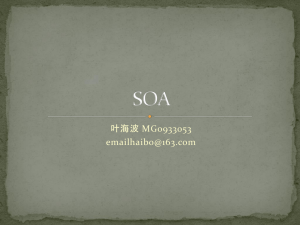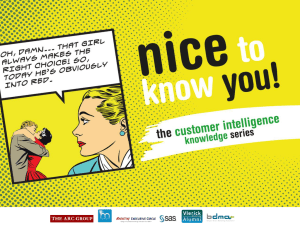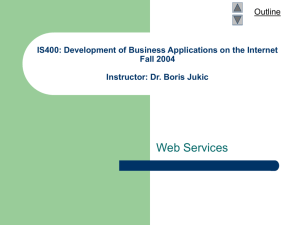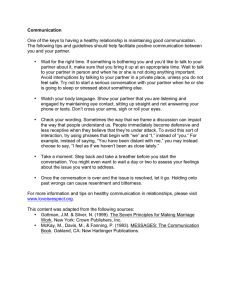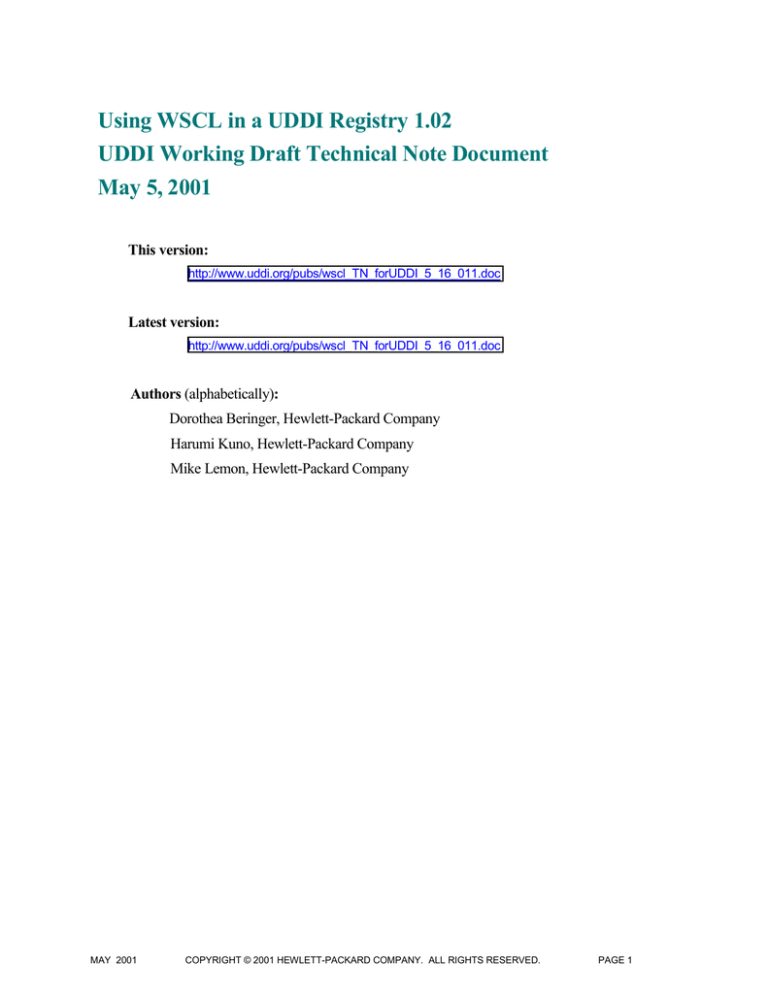
Using WSCL in a UDDI Registry 1.02
UDDI Working Draft Technical Note Document
May 5, 2001
This version:
http://www.uddi.org/pubs/wscl_TN_forUDDI_5_16_011.doc
Latest version:
http://www.uddi.org/pubs/wscl_TN_forUDDI_5_16_011.doc
Authors (alphabetically):
Dorothea Beringer, Hewlett-Packard Company
Harumi Kuno, Hewlett-Packard Company
Mike Lemon, Hewlett-Packard Company
MAY 2001
COPYRIGHT © 2001 HEWLETT-PACKARD COMPANY. ALL RIGHTS RESERVED.
PAGE 1
Contents
CONTENTS ...........................................................................................................................................................................2
MANAGEMENT OVERVIEW .........................................................................................................................................3
CURRENT SITUATION.....................................................................................................................................................3
USING WSCL CONVERSATION DESCRIPTIONS IN UDDI REGISTRIES .......................................................4
ACKNOWLEDGEMENTS ..............................................................................................................................................11
REFERENCES....................................................................................................................................................................12
APPENDIX A: EXAMPLE WSCL SPECIFICATION ...............................................................................................12
MAY 2001
© COPYRIGHT 2001 BY HEWLETT-PACKARD COMPANY
ALL RIGHTS RESERVED.
PAGE 2
Management Overview
Electronic commerce is moving towards a vision of web-service based interactions, where
corporate enterprises use web-services to interact with each other dynamically. For example, a
service in one enterprise could spontaneously decide to engage a service fronted by another
enterprise. In order for services to interact with each other dynamically, they must be able to do
three fundamental things.
1. Clients must be able to discover services.
2. A service must be able to describe its abstract interfaces and protocol bindings so that
clients can figure out how to invoke it.
3. A service must be able to describe the kinds of interactions (conversations) that it supports
(e.g., that it expects clients to login before they can request a catalog) so that it can
engage in complex exchanges with its clients.
The Universal Description Discovery and Integration (UDDI)[1-3] specifications address the first
problem by defining a way to publish and discover information about Web services. The Web
Services Description Language (WSDL)[4] addresses the second problem, defining a general
purpose XML language for describing the interface and protocol bindings of network services. The
1
Web Services Conversation Language (WSCL) [6] addresses the last problem, providing a
standard way to model the public processes of a service, thus enabling network services to
participate in rich interactions. Together, UDDI, WSDL, and WSCL enable developers to
implement web services capable of spontaneously engaging in dynamic and complex interenterprise interactions.
In this document, we clarify the relationship between WSCL, UDDI, and WSDL. In particular, we
describe how together these three components can be used to create an environment in which
services can spontaneously discover each other and then engage in complicated interactions.
Current Situation
Web-services are much more loosely coupled than traditional distributed applications. This
difference impacts both the requirements and usage models for web-services. Web-services are
deployed on the behalf of diverse enterprises, and the programmers who implement them are
unlikely to collaborate with each other during development. However, the purpose of web-services
is to enable business-to-business interactions. Therefore, web-services must support very flexible,
dynamic bindings. Web-services should be able to discover new services and interact with them
dynamically without requiring programming changes to either service.
The prevalent model for web-service communication is that web-services will publish information
about the specifications that they support. UDDI facilitates the publication and discovery of webservice information. The current version of WSDL (1.0) is an XML-based format that describes the
interfaces and protocol bindings of web service functional endpoints. WSDL also defines the
payload that is exchanged using a specific messaging protocol; SOAP is one such possible
messaging protocol. However, neither UDDI nor WSDL currently addresses the problem of how a
service can specify the sequences of legal message exchanges (interactions) that it supports.
The Web Services Conversation Language (WSCL) addresses this issue, providing an XML
schema for defining legal sequences of documents that web-services can exchange. Web services
interact by exchanging messages. Each message can be expressed as a structured document
(e.g., using XML) that is an instance of some document type (e.g., expressed using XML Schema).
A message may be wrapped (nested) in an encompassing document, which can serve as an
1
MAY 2001
WSCL is derived from the Conversation Definition Language (CDL).
© COPYRIGHT 2001 BY HEWLETT-PACKARD COMPANY
ALL RIGHTS RESERVED.
PAGE 3
envelope that adds contextual (delivery or conversation specific) information (e.g., using SOAP).
We define a conversation to be a sequence of message exchanges between two or more services.
We define a conversation specification to be a formal description of "legal" message type-based
conversations that a service supports. The complete specification of WSCL 1.0 can be found at
[6].
WSCL and WSDL are highly complimentary – WSDL specifies how to send messages to a service
and WSCL specifies the order in which such messages can be sent. The advantage of keeping
the two distinct is that doing so allows us to decouple conversational interfaces (represented by
WSCL) from service-specific interfaces (represented by WSDL). This means that a single
conversation specification can be implemented by any number of services, independent of the
protocols supported by the various implementations.
Using WSCL Conversation Descriptions in UDDI Registries
Usage of WSCL
WSCL specifies the public interface to web-services, it does not specify how the conversation
participants will handle and produce the documents received and sent. A conversation definition is
thus service independent, and can be used by any number of services with completely different
implementations. A conversation developer (e.g. a vertical standards body) can create a WSCL
description of some conversation, and publish it in a UDDI directory. A service provider who
wanted to create a service that supported that conversation description could create and document
service endpoints that support the message sequencing specified by the WSCL document. Any
software developer who wants to create an application using the published web-service can
download the WSCL files describing the conversations supported, and implement the necessary
interactions accordingly. Ideally, software developers creating and using web-services will be
supported by tools that allow them to interpret conversations and to easily and quickly map the
interactions outlined in the conversation definition to any existing applications and back-end logic,
while separating cleanly between the public and the private processes. Without any formal
definition of the conversations, such tool support will not be possible.
Figure 1 depicts a UML diagram of a simple purchase conversation definition from the perspective
of the seller. A service that supports this conversation definition expects a conversation to begin
with the receipt of a LoginRQ or a RegistrationRQ document. Once the service has received one
of these documents, it answers with a ValidLoginRS, a InvalidLoginRS, or a RegistrationRS,
depending on the type and content of the message received. The WSCL specification for this
conversation is given in Appendix A. Although this conversation is defined from the perspective of
the seller, it can be used to determine the appropriate message types and sequences for both the
seller and the buyer. The buyer simply derives his conversation definition by inverting the direction
of the messages’ halves of a conversation.
MAY 2001
© COPYRIGHT 2001 BY HEWLETT-PACKARD COMPANY
ALL RIGHTS RESERVED.
PAGE 4
<<ReceiveSend>>
Registration
in: RegistrationRQ
out: RegistrationRS
[InvalidLoginRS]
Login <<ReceiveSend>>
in: LoginRQ
out: ValidLoginRS
out: InvalidLoginRS
[InvalidLoginRS]
[ValidLoginRS]
<<ReceiveSend>>
CatalogInquiry
in: CatalogRQ
out: CatalogRS
<<ReceiveSend>>
Quote
in: QuoteRQ
out: QuoteRS
[InvalidPaymentRS]
<<ReceiveSend>>
Purchase
in: PurchaseRQ
out: PurchaseAcceptedRS
out: InvalidPaymentRS
out: OutOfStockRS
<<Receive>>
Logout
in: LogoutMessage
[PurchaseAcceptedRS]
<<Send>>
Shipping
out: ShippingInformation
[OutOfStockRS]
[InvalidPaymentRS]
Figure 1: An example conversation depicted as a UML activity diagram.
Interactions are represented by action states.
Authoring WSCL Conversation Specifications
There are four elements to a WSCL specification:
•
Document type descriptions specify the types (schemas) of XML documents that the service
can accept and transmit in the course of a conversation. The schemas of the documents
exchanged are not specified as part of the WSCL specification document; the actual document
schemas are separate XML documents and are referenced by their URL in the interaction
elements of the conversation specification.
•
Interactions model the actions of the conversation as document exchanges between
conversation participants. E.g., in figure 1, the interaction “Login” is defined as consisting of a
the inbound message “LoginRQ” and either the outbound message “ValidLoginRS” or
“InvalidLoginRS”. For all these messages, the WSCL description also specifies the URL of the
schema for the document type exchanged. WSCL currently supports four types of interactions:
Send (the service sends out an outbound document), Receive (the service receives an
inbound document), SendReceive (the service sends out an outbound document, then
expects to receive an inbound document in reply), and ReceiveSend (the service receives an
inbound document and then sends out an outbound document). The Empty interaction does
MAY 2001
© COPYRIGHT 2001 BY HEWLETT-PACKARD COMPANY
ALL RIGHTS RESERVED.
PAGE 5
not contain any documents exchanged, it is just used for modeling the start and end of a
conversation.
•
Transitions specify the ordering relationships between interactions. A transition specifies a
source interaction, a destination interaction, and optionally a document type of the source
interaction as additional condition for the transition. E.g., in figure 1, after a “Purchase”
interaction the conversation may either transition to the “Send”, “Purchase” or final interaction,
depending on the outbound document exchanged in the Purchase interaction.
•
The Conversation element lists all the interactions and transitions that make up the
conversation. It also contains additional information about the conversation like its name, and
with which interaction the conversation may start and end. A conversation can also be thought
of as being one of the interfaces or public processes supported by a service. Yet in contrast to
interfaces as defined by CORBA IDE or Java interfaces, conversations also specify the
possible ordering of operations, i.e. the possible sequences in which documents may be
exchanged.
We now examine the XML representation of the conversation depicted in Figure 1, specified using
WSCL (the full example can be found in Appendix A). The root Conversation element has
attributes specifying a name for the conversation and the initial and final interactions, and contains
two sub-elements: a ConversationInteractions element that contains a list of Interaction elements,
and a ConversationTransitions element that consists of a list of Transition elements. WSCL does
not restrict how to name conversations.
<?xml version="1.0" encoding="UTF-8"?>
<Conversation name="StoreFrontServiceConversation"
initialInteraction="Start" finalInteraction="End"
<ConversationInteractions>
<Interaction … />
<Interaction … />
…
</ConversationInteractions>
<ConversationTransitions>
<Transition … />
<Transition … />
…
</ConversationTransitions>
</Conversation>
>
The following XML code is a WSCL representation of the “Login” interaction, an interaction of type
ReceiveSend that specifies several possible outbound documents, only one of which is exchanged
at run-time.
<Interaction interactionType="ReceiveSend" id="Login">
<InboundXMLDocument id="LoginRQ"
hrefSchema="http://conv123.org/LoginRQ.xsd" />
<OutboundXMLDocument id="ValidLoginRS"
hrefSchema="http://conv123.org/ValidLoginRS.xsd" />
<OutboundXMLDocument id="InvalidLoginRS"
hrefSchema="http://conv123.org/InvalidLoginRS.xsd" />
</Interaction>
Note that this interaction is assigned the identifier “Login.” Also, note that each document type is
assigned an identifier (e.g., “InvalidLoginRS”). The identifiers defined for the interactions and their
documents are used when specifying the source and destination interactions for the conversation’s
transitions.
Transitions indicate the possible progression of the conversation between interactions. For
example, the following XML code specifies that there is a possible transition from the “Login” to the
“Quote” interaction, from the “Login” to the “CatalogInquiry” interaction, and from the “Login” to the
“Registration” interaction. After sending out one of the outbound documents of the “Login”
interaction, the service can receive e.g. a “RegistrationRQ”, “CatalogRQ”, or a “QuoteRQ”
MAY 2001
© COPYRIGHT 2001 BY HEWLETT-PACKARD COMPANY
ALL RIGHTS RESERVED.
PAGE 6
document. In this specific case the next valid document also depends on the type of outbound
document sent out in the “Login” interaction.
<Transition>
<SourceInteraction href="Login"/>
<DestinationInteraction href="Registration"/>
<SourceInteractionCondition href="InvalidLoginRS"/>
</Transition>
<Transition>
<SourceInteraction href="Login"/>
<DestinationInteraction href="CatalogInquiry"/>
<SourceInteractionCondition href="ValidLoginRS"/>
</Transition>
<Transition>
<SourceInteraction href="Login"/>
<DestinationInteraction href="Quote"/>
<SourceInteractionCondition href="ValidLoginRS"/>
</Transition>
Although WSCL specifies the valid inbound and outbound documents for an interaction, it does not
specify how the conversation participants will handle and produce these documents. The WSCL
specification of a conversation is thus service-independent, and can be used (and reused) by any
number of service providers and service consumers.
The full conversation definition for Figure 1’s example conversation is listed in Appendix A.
Relevant UDDI Structures
A UDDI business registration is an XML document that describes a business entity and its web
services. The UDDI XML schema defines four core types of service information: business
information (such as business name and contact information), business service information
(general technical and business descriptions of web services), binding information (specific
information needed to invoke a service), and service specification information (associating a
service’s binding information with the business service information it implements).
Programmers and programs can use the UDDI Business Registry to locate technical information
about services, such as the protocols and specifications that they implement. More importantly,
the UDDI Business Registry also serves as a registry for abstract (service-independent)
specifications. Services can refer indirectly to the UDDI registrations for specifications they
implement, which makes it straightforward to identify the business service information that
represents a given service.
The UDDI tModel is a meta-data construct that uniquely identifies reusable service-related
technical specifications for reference purposes. A service publishes tModelInstanceDetails, which
is a list of tModelInfo elements that refer to the tModels that the service supports. A UDDI tModel
data structure includes a unique key (tModelKey attribute), an name element, an optional
description, and an overviewDoc element in which we can store a URL for the actual specification
document.
We can use the tModel structure to register WSCL conversation specifications. Each tModel
should be classified in the uddi-org:types taxonomy as being of type “wsclSpec” and must have an
overviewDoc element whose overviewURL points to the actual WSCL document.
For example, suppose we wanted to register a WSCL specification of the “storefront” conversation
depicted in Figure 1 in a UDDI registry. We would create a tModel entry within the UDDI registry
that referred to the actual WSCL specification document in its overviewDoc element. The following
XML code is a UDDI tModel reference for a WSCL specification for a service conversation.
MAY 2001
© COPYRIGHT 2001 BY HEWLETT-PACKARD COMPANY
ALL RIGHTS RESERVED.
PAGE 7
<tModel authorizedName=”XXXX” operator=”YYYY” tModelKey=”ZZZZ”>
<name>StoreFrontServiceConversation</name>
<description xml:lang=”en”>
WSCL description of a simple storefront conversation
</description>
<overviewDoc>
<description xml:lang=”eng”>WSCL source document.</description>
<overviewURL>http://example.com/schema_files/StoreFront101.wscl
</overviewURL>
</overviewDoc>
</tModel>
This storefront conversation tModel can now be referenced by the tModelInstanceInfo of any
service that implements that conversation type:
<businessService>
…
<bindingTemplates>
<bindingTemplate>
…
<accessPoint urlType=”http”>http://www.foo.com/</accessPoint>
<tModelInstanceDetails>
<tModelInstanceInfo tModelKey=”ZZZZ”> … </tModelInstanceInfo>
</tModelInstanceDetails>
…
</bindingTemplate>
…
<bindingTemplates>
<businessService>
Relevant WSDL Structures
As noted before, WSCL specifications are conversation-specific. WSCL describes the structures
(types) of documents a service expects to receive and produce, as well as the order in which
document interchanges will take place, but does not specify how to dispatch received documents
to the service. This is partially addressed by WSDL. WSDL documents describe part of the
abstract interface as well as the protocol bindings of a network service. WSDL specifications that
describe abstract protocol interfaces are reusable and thus can be registered as UDDI tModels [5].
When describing web services we can distinguish between three main aspects:
•
Abstract interface (public process, business model): the messages or documents
(business payload) being exchanged and the order in which they are exchanged
(choreography of the messages).
•
Protocol binding: the protocols used for exchanging the documents.
•
Services: the concrete service implementing a set of abstract interfaces and protocol
bindings, and its location.
The following table shows how these three different aspects are covered by WSDL and WSCL. It is
evident that the only overlap between WSDL and WSCL exists in the specification of the
documents being exchanged:
Abstract
choreography
Interfaces messages
Protocol Bindings
Concrete Services
MAY 2001
WSDL
out of scope
Operation
Binding
Service
WSCL
Transition
Interaction
out of scope
out of scope
© COPYRIGHT 2001 BY HEWLETT-PACKARD COMPANY
ALL RIGHTS RESERVED.
PAGE 8
Where WSDL and WSCL overlap, we can map the different terminology used as follows:
WSDL
Port Type
Operation:
One-way
Request-response
Solicit-response
Notification
Input
Output, Fault
Names of Operation, Input,
Output, Fault
Message
WSCL
Conversation
2
Interaction :
Receive
ReceiveSend
SendReceive
Send
InboundXMLDocument
OutboundXMLDocument
Id of Interaction, InboundXMLDocument,
OutboundXMLDocument
URL of XML schema (WSCL delegates the
specification of the payload entirely to an external
XML schema, whereas WSDL directly uses XML data
types)
There are three approaches for combining WSDL and WSCL descriptions of a web service:
1. Adding protocol bindings in WSDL to a conversation described in WSCL: If the abstract
interface is already completely described by a WSCL document, we can go ahead and use the
WSDL Binding elements to describe the protocol binding. Example:
<?xml version="1.0" encoding="UTF-8"?>
<definitions name="MyStoreFrontService"
targetNamespace=…
xmlns:conv=”http://example.com/Conversations/StoreFront.cdl” >
<binding name="StoreFrontServiceConversationBinding"
type="conv:StoreFrontServiceConversation">
<soap:binding style=”document”/>
<operation name=”conv:Login”>
<soap:operation soapAction=”Login”>
</operation>
<operation name=”conv:Registration”>
<soap:operation soapAction=”Registration”>
</operation>
… for all other interactions
</binding>
<service name=”MyStoreFrontService”>
<port name=”MyStoreFrontServiceAccessPoint”
binding=”StoreFrontServiceConversationBinding”>
<soap:Address location=”http://mystore.com/storefront” />
</port>
</service>
</definitions>
In this example the attribute type in the element binding refers to the name of the conversation
in the WSCL document describing this conversation. The names of the operations refer to the
ids of the interactions, the type attribute of the binding refers to the name of the conversation in
the WSCL document.
2. Adding choreography to a WSDL port type description: If a port type is already described by a
WSDL document, we can describe the choreography in an additional WSCL document that
only contains transition elements. The subelements SourceInteraction and
2
The interaction of type “Empty” does not appear in this list as it is only used for modeling the start and end state of
conversations, and does not contain any documents exchanged.
MAY 2001
© COPYRIGHT 2001 BY HEWLETT-PACKARD COMPANY
ALL RIGHTS RESERVED.
PAGE 9
DestinationInteraction refer to the names of operations from the WSDL document, and the
3
subelement SourceInteractionCondition refers to an output or fault message of the operation.
3. Providing a full WSDL and WSCL description for the same port type / conversation: We can
also express which documents get exchanged by both, a WSDL port type and a WSCL
conversation, with the conversation also describing the choreography used. The following
example describes the interaction “Login” from the WSCL example in the appendix as a
WSDL operation:
<?xml version="1.0" encoding="UTF-8"?>
<definitions name="MyStoreFrontService"
targetNamespace=…
xmlns:xsd1=”http://example.com/types/LoginRQ.xsd”
xmlns:xsd2=”http://example.com/types/ValidLoginRS.xsd”
xmlns:xsd3=”http://example.com/types/InvalidLoginRS.xsd” >
<message name=”LoginRequestDocument”>
<part name=”body” element=”xsd1:LoginRQElement” />
</message>
<message name=”ValidLoginDocument”>
<part name=”body” element=”xsd2:ValidLoginRSElement” />
</message>
<message name=”InvalidLoginDocument”>
<part name=”body” element=”xsd3:InvalidLoginRSElement” />
</message>
<portType name="StoreFrontServiceConversation" >
<operation name=”Login”>
<input name=”LoginRQ” message=”LoginRequestDocument”/>
<output name=”ValidLoginRQ” message=”ValidLoginDocument”/>
<fault name=”InvalidLoginRQ” message=”InvalidLoginDocument”/>
</operation>
</portType>
</definitions>
Referencing WSCL as well as WSDL Descriptions
The UDDI registry uses businessService data structures to store information about the specific
services offered by a given business entity. Each businessService structure represents a logical
service classification of a single businessEntity structure, and in turn uses bindingTemplate
structures to hold the technical characteristics of the service. Each bindingTemplate structure
includes tModelInstanceDetails, which is a list of tModelInfo structures. Each tModelInfo structure
is a reference to a single tModel.
For example, suppose that we had a WSCL specification located at http://conversationdefinitions/storefrontConversation.wscl, and WSDL specification containing binding information
located at http://example.com/storefrontBinding.wsdl. We assume that in this example the WSDL
document either references the interactions of the WSCL document in its binding elements, or that
the two documents use the same names for interactions and document types, so the descriptions
can be mapped as described above. UDDI tModels that refer to these documents might look like
the following:
<tModel authorizedName=”…” operator=”…” tModelKey=”1B345”>
<name>StoreFrontServiceConversation</name>
<description xml:lang=”en”>
WSCL description of a simple storefront conversation
</description>
<overviewDoc>
3
WSCL uses attributes of type HREF to refer to other elements. Therefore, in order to refer to operations from a WSDL
document the WSCL schema needs to be slightly adapted in order to accept also values of type QNAME.
MAY 2001
© COPYRIGHT 2001 BY HEWLETT-PACKARD COMPANY
ALL RIGHTS RESERVED.
PAGE 10
<description xml:lang=”eng”>WSCL source document.</description>
<overviewURL>http://example.com/schema_files/StoreFront101.wscl
</overviewURL>
</overviewDoc>
</tModel>
<tModel authorizedName=”…” operator=”…” tModelKey=”2B345”>
<name>StoreFrontServiceBinding</name>
<description xml:lang=”en”>
WSDL description of a the binding of a storefront conversation
</description>
<overviewDoc>
<description xml:lang=”eng”>WSDL source document.</description>
<overviewURL>http://example.com/schema_files/StoreFront78.wsdl
</overviewDoc>
</tModel>
<tModel authorizedName=”…” operator=”…” tModelKey=”3B345”>
<name>StoreFrontServiceInstance</name>
<description xml:lang=”en”>
WSDL description of a concrete service, listing bindings supported and
addresses of these bindings
</description>
<overviewDoc>
<description xml:lang=”eng”>WSDL source document.</description>
<overviewURL>http://example.com/schema_files/StoreFrontMyService.wsdl
</overviewDoc>
</tModel>
The UDDI businessService structure for a service that supports these tModels would look like the
following:
<businessService>
…
<bindingTemplates>
<bindingTemplate>
…
<accessPoint urlType=”http”>http://www.foo.com/</accessPoint>
<tModelInstanceDetails>
<tModelInstanceInfo tModelKey=”1B345”> … </tModelInstanceInfo>
<tModelInstanceInfo tModelKey=”2B345”> … </tModelInstanceInfo>
<tModelInstanceInfo tModelKey=”3B345”> … </tModelInstanceInfo>
…
</tModelInstanceDetails>
…
<bindingTemplate>
…
<bindingTemplates>
<businessService>
Acknowledgements
We would like to thank Alan Karp, David Ehnebuske, Kannan Govindarajan, and Gregory
Pogossiants for their comments and suggestions regarding this work. We owe special thanks to
David Ehnebuske for his help with the WSDL-related issues.
MAY 2001
© COPYRIGHT 2001 BY HEWLETT-PACKARD COMPANY
ALL RIGHTS RESERVED.
PAGE 11
References
[1]
Ariba, International Business Machines Corporation, Microsoft Corporation, UDDI
Technical White Paper, Sep 6, 2000.
[2]
Boubez, T., Hondo, M., Kurt, C., Rodriguez, J., and Rogers, D., UDDI Programmer's
API 1.0, Sep 20, 2000.
[3]
Boubez, T., Hondo, M., Kurt, C., Rodriguez, J., and Rogers, D., UDDI Data Structure
Reference V1.0, Sep 30, 2000.
[4]
Web page: Web Services Description Language (WSDL) 1.0. URL:
http://msdn.microsoft.com/xml/general/wsdl.asp
[5]
Curbera, F., Ehnebuske, D., Rogers, D., Using WSDL in a UDDI Registry 1.02,
http://www.uddi.org/bestpractices.html
[6]
Web-Services Conversation Language WSCL 1.0, May 2001, http://www.hp.com/go/espeak
Appendix A: Example WSCL Specification
The following XML document is an example of a WSCL specification for a conversation supported by
a storefront service. Figure 1 shows the transition graph expressed in this conversation definition.
<?xml version="1.0" encoding="UTF-8"?>
<Conversation name="StoreFrontServiceConversation"
targetNamespace=http://example.com/conversations/StoreFront101
hrefSchema=”http://example.com/schema_files/StoreFront101.wscl”
initialInteraction="Start" finalInteraction="End" >
<ConversationInteractions>
<Interaction interactionType="ReceiveSend" id="Login">
<InboundXMLDocument hrefSchema="http://conv123.org/LoginRQ.xsd"
id="LoginRQ"/>
<OutboundXMLDocument hrefSchema="http://conv123.org/ValidLoginRS.xsd"
id="ValidLoginRS"/>
<OutboundXMLDocument hrefSchema="http://conv123.org/InvalidLoginRS.xsd"
id="InvalidLoginRS" />
</Interaction>
<Interaction interactionType="ReceiveSend" id="Registration">
<InboundXMLDocument hrefSchema="http://conv123.org/RegistrationRQ.xsd"
id="LoginRQ"/>
<OutboundXMLDocument hrefSchema="http://conv123.org/RegistrationRS.xsd"
id="RegistrationRS"/>
</Interaction>
<Interaction interactionType="Receive" id="Logout">
<InboundXMLDocument hrefSchema="http://conv123.org/Logout.xsd"
id="LogoutMessage"/>
<OutboundXMLDocument hrefSchema="http://conv123.org/RegistrationRS.xsd"
id="RegistrationRS"/>
</Interaction>
<Interaction interactionType="ReceiveSend" id="CatalogInquiry" >
<InboundXMLDocument hrefSchema=http://conv123.org/CatalogRQ.xsd
id="CatalogRQ"/>
<OutboundXMLDocument hrefSchema="http://conv123.org/CatalogRS.xsd"
id="CatalogRS" />
</Interaction>
<Interaction interactionType="ReceiveSend" id="Quote" >
MAY 2001
© COPYRIGHT 2001 BY HEWLETT-PACKARD COMPANY
ALL RIGHTS RESERVED.
PAGE 12
<InboundXMLDocument hrefSchema="http://conv123.org/QuoteRQ.xsd"
id="QuoteRQ" />
<OutboundXMLDocument hrefSchema="http://conv123.org/QuoteRS.xsd"
id="QuoteRS" />
</Interaction>
<Interaction interactionType="ReceiveSend" id="Purchase" />
<InboundXMLDocument hrefSchema="http://conv123.org/PurchaseOrderRQ.xsd"
id="PurchaseOrderRQ" />
<OutboundXMLDocument id="PurchaseOrderAcceptedRS"
hrefSchema="http://conv123.org/PurchaseOrderAcceptedRS.xsd" />
<OutboundXMLDocument id="InvalidPaymentRS"
hrefSchema="http://conv123.org/InvalidPaymentRS.xsd" />
<OutboundXMLDocument id="OutOfStockRS"
hrefSchema="http://conv123.org/OutOfStockRS.xsd" />
</Interaction>
<Interaction interactionType="Send" id="Shipping" >
<OutboundXMLDocument id="ShippingInformation"
hrefSchema="http://conv123.org/ShippingInformation.xsd" />
</Interaction>
<Interaction interactionType="Empty" id="Start" />
<Interaction interactionType="Empty" id="End" />
</ConversationInteractions>
<ConversationTransitions>
<Transition>
<SourceInteraction href="Start"/>
<DestinationInteraction href="Login"/>
</Transition>
<Transition>
<SourceInteraction href="Start"/>
<DestinationInteraction href="Login"/>
</Transition>
<Transition>
<SourceInteraction href="Registration"/>
<DestinationInteraction href="Registration"/>
</Transition>
<Transition>
<SourceInteraction href="Login"/>
<DestinationInteraction href="Registration"/>
<SourceInteractionCondition href="InvalidLoginRS"/>
</Transition>
<Transition>
<SourceInteraction href="Login"/>
<DestinationInteraction href="Login"/>
<SourceInteractionCondition href="InvalidLoginRS"/>
</Transition>
<Transition>
<SourceInteraction href="Login"/>
<DestinationInteraction href="CatalogInquiry"/>
<SourceInteractionCondition href="ValidLoginRS"/>
</Transition>
<Transition>
<SourceInteraction href="Login"/>
<DestinationInteraction href="Quote"/>
<SourceInteractionCondition href="ValidLoginRS"/>
</Transition>
<Transition>
<SourceInteraction href="Login"/>
<DestinationInteraction href="Purchase"/>
<SourceInteractionCondition href="ValidLoginRS"/>
</Transition>
<Transition>
<SourceInteraction href="CatalogInquiry"/>
<DestinationInteraction href="CatalogInquiry"/>
</Transition>
MAY 2001
© COPYRIGHT 2001 BY HEWLETT-PACKARD COMPANY
ALL RIGHTS RESERVED.
PAGE 13
<Transition>
<SourceInteraction href="CatalogInquiry"/>
<DestinationInteraction href="Quote"/>
</Transition>
<Transition>
<SourceInteraction href="Quote"/>
<DestinationInteraction href="CatalogInquiry"/>
</Transition>
<Transition>
<SourceInteraction href="Quote"/>
<DestinationInteraction href="Purchase"/>
</Transition>
<Transition>
<SourceInteraction href="Purchase"/>
<DestinationInteraction href="Purchase"/>
<SourceInteractionCondition href="InvalidPaymentRS"/>
</Transition>
<Transition>
<SourceInteraction href="Purchase"/>
<DestinationInteraction href="Shipping"/>
<SourceInteractionCondition href="PurchaseAcceptedRS"/>
</Transition>
<Transition>
<SourceInteraction href="Shipping"/>
<DestinationInteraction href="End"/>
</Transition>
<Transition>
<SourceInteraction href="Purchase"/>
<DestinationInteraction href="End"/>
<SourceInteractionCondition href="InvalidPaymentRS"/>
</Transition>
<Transition>
<SourceInteraction href="Purchase"/>
<DestinationInteraction href="End"/>
<SourceInteractionCondition href="OutOfStockRS"/>
</Transition>
<Transition>
<SourceInteraction href="Quote"/>
<DestinationInteraction href="Logout"/>
</Transition>
<Transition>
<SourceInteraction href="CatalogInquiry"/>
<DestinationInteraction href="Logout"/>
</Transition>
<Transition>
<SourceInteraction href="Logout"/>
<DestinationInteraction href="End"/>
</Transition>
</ConversationTransitions>
</Conversation>
MAY 2001
© COPYRIGHT 2001 BY HEWLETT-PACKARD COMPANY
ALL RIGHTS RESERVED.
PAGE 14

